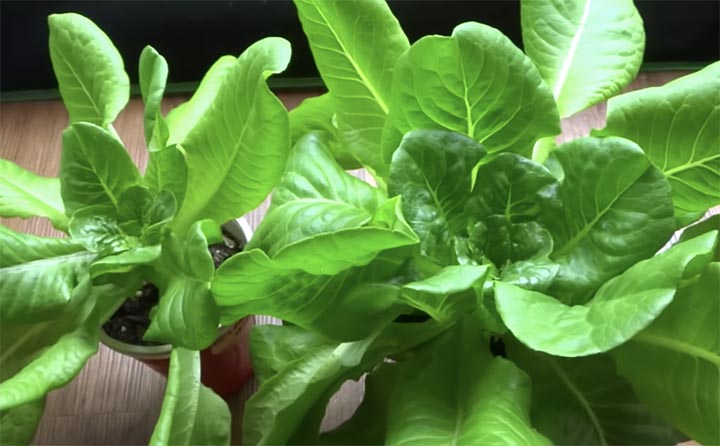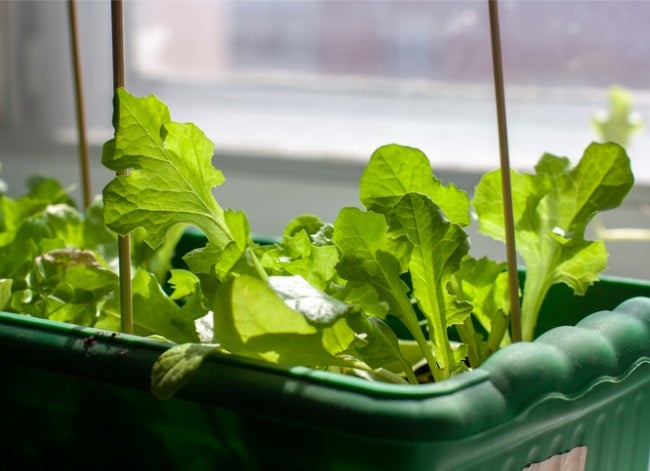
×

Lettuce is a delicious and versatile vegetable that can be grown indoors year-round. It is a relatively easy crop to grow, and with a little care, you can enjoy fresh, home-grown lettuce in no time.

One of the best things about grow lettuce indoors is that you can start from seed. This gives you more control over the type of lettuce you grow, and it’s also a more economical way to start your garden.
1. Lettuce seeds
2. Potting soil
3. A container with drainage holes
4. A sunny windowsill
1. Fill the container with potting soil.
2. Sow the lettuce seeds according to the package directions.
3. Lightly water the seeds.
4. Place the container in a sunny windowsill.
5. Keep the soil moist
6. But not soggy
The lettuce seeds will germinate in about 7-10 days. Once the seedlings have their first set of true leaves, you can thin them out to about 2 inches apart.
There are many benefits to growing lettuce indoors. Here are few of them :-
1. Fresh lettuce is always available.
2. You can control the growing conditions.
3. You can grow lettuce year-round.
4. Easy crop to grow.

There is something truly special about grow lettuce indoors from scratch. It is a rewarding experience to watch the seeds germinate and the seedlings grow into healthy plants. And, of course, there is nothing quite like the taste of fresh, home-grown lettuce.
If you are looking for a new gardening challenge, We encourage you to try grow lettuce indoors. It is a relatively easy crop to grow, and the rewards are well worth it.
If you have a head of romaine lettuce that is starting to get a little wilted, don’t throw it away! You can actually regrow it in water. This is a great way to extend the life of your lettuce and have fresh greens on hand for salads or sandwiches.
1. Cut the bottom inch or so of the lettuce stem.
2. Remove the outer leaves.
3. Place the lettuce stem in a glass filled with water
4. Place the glass in direct sunlight.
5. Change the water every few days.
Within a few days, you will see new roots and leaves start to grow. Once the roots are about 2 inches long, you can transplant the lettuce into a pot of potting soil.
1. Choose a sunny windowsill for your lettuce plants.
2. Water your lettuce plants regularly, but don’t overwater them.
3. Fertilize your lettuce plants every few weeks with a balanced fertilizer.
4. Harvest your lettuce leaves
5. When they are young and tender
1. Use a shallow container. Lettuce has shallow roots, so you don't need a deep container. A pot that is about 6 inches deep is sufficient.
2. Use a well-draining potting mix. Lettuce plants don't like wet feet, so make sure the potting mix you use drains well.
3. Water your plants from the bottom. This will help prevent the leaves from getting wet, which can lead to disease.
4. Fertilize your plants regularly.
5. Use a balanced fertilizer, such as a 10-10-10 fertilizer.
6. Harvest your leaves regularly.
7. This will encourage the plant to produce more leaves.
8. Rotate your plants.
9. This will prevent the plants from getting leggy.
10. Pests and diseases. Lettuce is susceptible to a few pests and diseases, such as aphids, whiteflies, and powdery mildew.
11. If you see any pests or diseases, take action immediately to prevent them from spreading.
With these tips, you'll be well on your way to growing delicious, home-grown lettuce indoors all year long!
Read Also: The Ultimate Guide To Planting And Maintaining A Flower Pot
1. If you live in a warm climate, you may need to use a fan to help circulate the air around your plants. This will assist with keeping the leaves from getting excessively hot and shrivelling.
2. If you don't have a sunny windowsill, you can use grow lights to provide your plants with the light they need. However, it's important to make sure that the grow lights are not too close to the plants, as this can burn the leaves.
3. If you're growing lettuce in a small space, you can try growing it in a vertical garden. This is a great way to save space and still have fresh lettuce on hand.
4. If you're a beginner gardener, you may want to start with a fast-growing variety of lettuce, such as leaf lettuce or butter head lettuce. These varieties will mature in about 4-6 weeks, so you'll be able to enjoy fresh lettuce in no time.
5. Lettuce is a low-maintenance crop, so even if you're a beginner gardener, you can still grow it successfully.
6. Lettuce is a versatile vegetable that can be used in a variety of dishes, such as salads, sandwiches, and wraps.
7. Lettuce is a good source of vitamins A and C, as well as fiber.
8. Growing your own lettuce is a great way to save money and have fresh, home-grown lettuce on hand whenever you need it.
.